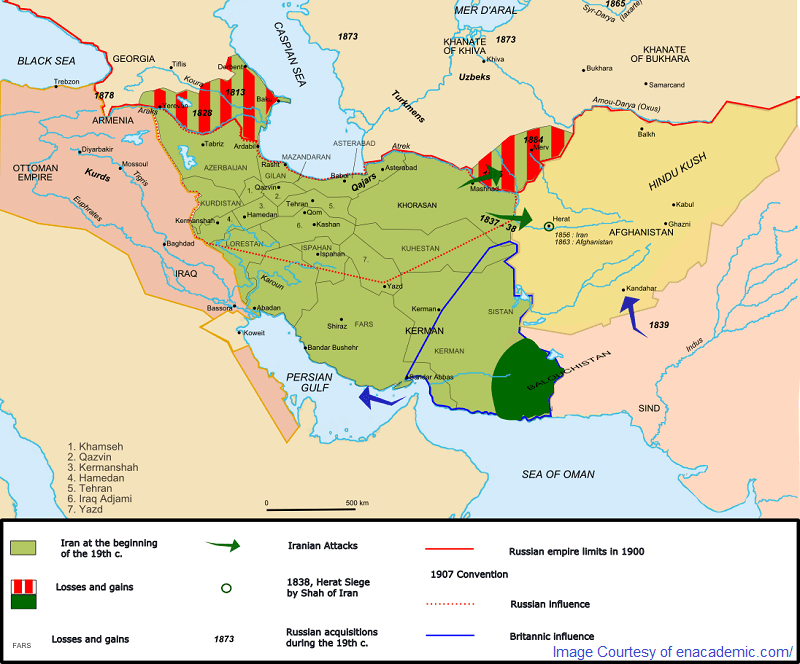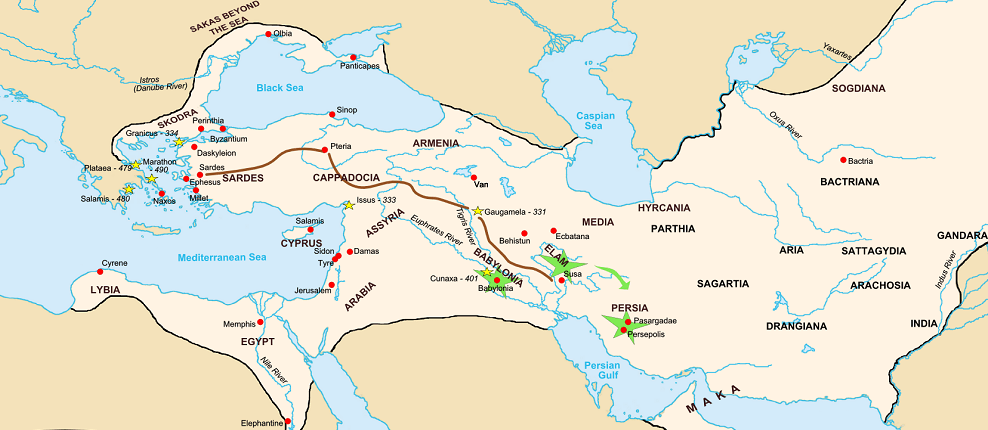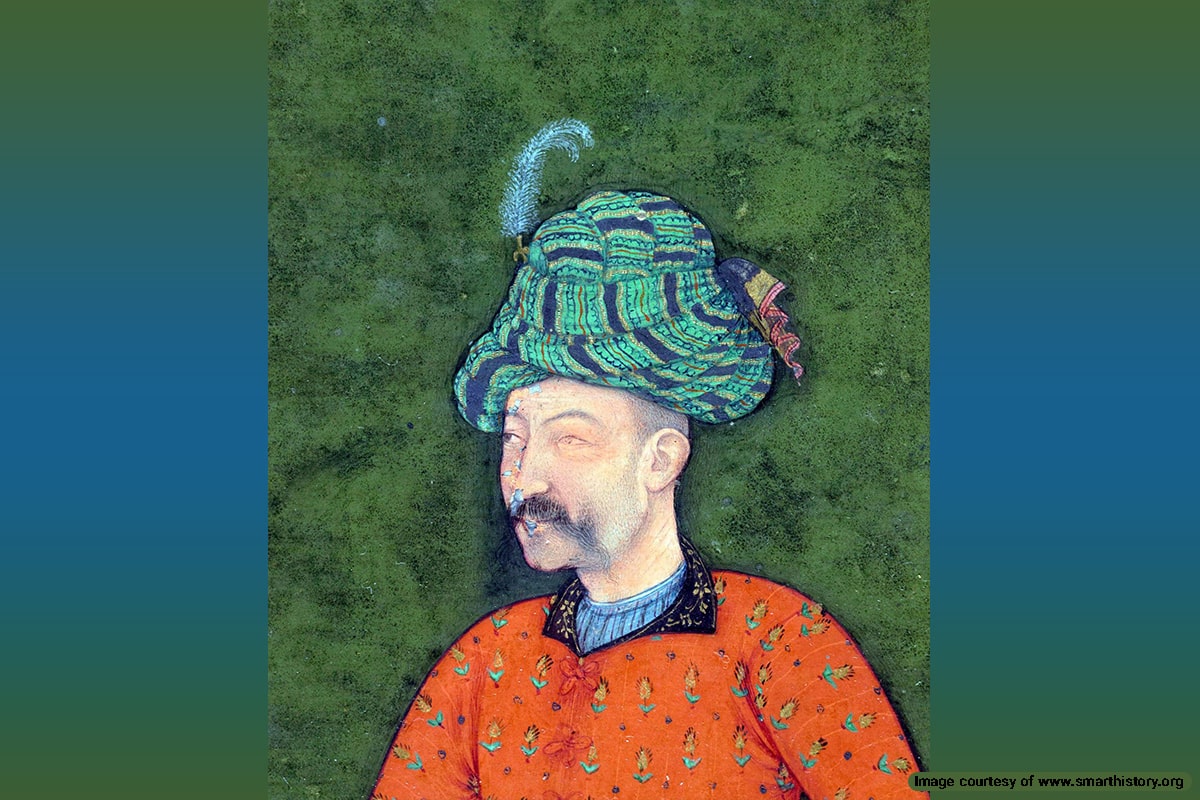
The history of Qajars was like another chapter of the declined and corrupted period of Safavids’ rule. Qajar kings were of Turcoman origin. Although Turkish was the language of the court, the language of the administration was Persian.
The Situation Prior & During the Qajars
They came to power after years of turmoil, war, famine and population-reducing contagious diseases. There were still the same old disputes between Shiites and Sunnis. Iran was not a unified nation. Ottomans, Uzbeks, and Turkmen continued to be major threats at the borders. Two new major challenges threatened Iran’s territorial integrity: Russians from north and Brits from the south.
Britain and France were competing to access and gain control over India. Promising military aids to Iran and helping to regain Georgia, France urged Iran to attack India. To prevent its rival’s victory, Britain promised to supply weapons and equip the Iranian army against the Russians invasion.
Later, France and Russia concluded a friendly treaty. So, Iran could not count on the French government’s friendship anymore. Under such circumstances, the British government did not do anything to the advantage of Iran either.
In foreign affairs, Iran was short of incorruptible agents and representatives. Also, Iran needed people who knew the world and international norms and rules. If there were such people in Iran, they were never promoted to such positions as they could represent Iran in the international scenes.
The Industrial Revolution and the French revolution had initiated a new era in the lives of Europeans and was proceeding fast. During that time, Iran was stuck in despotism and religious biases. Thus, people’s ignorance of world developments continued. Qajar kings and top officials did not allow or approve the intellectuals to help Iran with its administration system.
Narrow-mindedness and sever biases helped the ongoing lack of tolerance and justice. The dominant spirit of the officials was to oppose anything new and unfamiliar. If they thought some new ideas or systems could separate them from their inherited traditions, they would definitely oppose it.
The History of Qajar Kings’ Efficiency
Helped by Haj Ebrahim Kalantar, Agha Mohammad Khan founded the Qajar dynasty and declared Tehran as his capital. Tehran was closer to the Turkmen nomads he had been originated from, Gorgan.
He had been castrated at the court of Zand when he was 6. This bitter experience together with several other childhood difficulties had made him a tough revengeful dictator. He was quick in decision-making and persistent in reaching his goals. Like Nader Shah, Agha Mohammad Khan had first decided to push back Uzbeks and Georgians, but he did not perform these tasks wisely. Also, he was showing lots of brutality in dealing with various issues. Therefore, he was assassinated by his servants.
Helped by Haj Ebrahim Kalantar, his nephew, Fath Ali, became the next king. He succeeded to eliminate all problems including others who had claimed for the throne. His chancellor was very helpful in this campaign too. So, he ordered several people to be arrested, mutilated, exiled and killed under torture in one day. His chancellor was also among those people because Fath Ali Shah regarded him as a threat to his crown too.
Then, when he felt relieved, Fath Ali Shah assigned his sons to rule in different parts of Iran. Having done so, he went to his huge harem for the rest of his life to spend his time with his wives and enjoy the companion of his poets and those who flattered him.
After Fath Ali Shah died, Mohammad Mirza, his son, ascended the throne. Russian and British governments supported him as the new king of Iran, hence disappointing his rivals. His chancellor, Mirza Abolqasem, initiated some reforms in the court and administration. Of course, the reforms were not pleasing for courtiers at all. He even limited the influence of the king and his close companions in lawful issues.
The courtiers supported by foreigners’ thoughts and financial resources, made Mohammad Mirza pessimistic about Mirza Abolqasem. They infuse Mohammad Mirza that his chancellor had planned to replace him. Brits were working toward the same goal. Ultimately, the king ordered to arrest him and later suffocated him in the same prison.
Haji Mirza Aghasy, who played a major role in getting rid of the former chancellor, was chosen as the next chancellor. Two years later, when Mohammad Shah realized he could not do the job efficiently, he did not dare to remove him from the office as Haji Mirza Aghasy was his spiritual teacher!
Mohammad Shah’s attack on Herat was faced with Britain’s dissatisfaction and threat. Brits occupied Iranian island, Khark, in the Persian Gulf. Mohamad Shah’s next move was to punish Ottomans because of their occupying Karbala. Russia and Britain intermediated between Iran and the Ottoman government. The result was a treaty according to which the western bank of Arvand Rud (Arabs call it Shat-Ol-Arab) belonged to Iran and Iranian vessels could navigate in its eastern half.
Foreign Influence & Intervention in the History of Qajars
The history of Qajars is the beginning of plenty of aggressive intervention and the influence of foreigners in Iranian politics.
After Mohammad Shah died, his 17-year-old son, Naser-ed-Din, succeeded him. He ruled for approximately 50 years. Mirza Taqi Khan Farahany (titled as Amir Kabir) was chosen as his chancellor. He set things in order pretty rapidly. He reorganized the army, improved the expenditure policies, omitted and adjusted unreasonable salaries and pensions, published a governmental newspaper called “Vaqaye Ettefaqiey” and so forth. He is considered the vanguard of modernizing Iran.
Amir Kabir founded a modern school for military, engineering and medicine studies called “Dar-Ol-Fonoon”. He also employed teachers from Austria, Italy, and France. Before the inauguration of the school, Naser-ed-Din Shah was infused about Amir Kabir’s popularity serving as a threat to his throne. So, he exiled the chancellor to Kashan and later assassinated him over there. Amir Kabir was a victim of the intrigues and plots of Naser-ed-Din Shah’s mother and Mirza Aqa Khan Noory.
The next chancellor was Mirza Aqa Khan Noory, a British citizen! As Naser-ed-Din Shah was spending his time in various pleasures, he was betraying the country. Finally, Naser-ed-Din Shah removed him from the office.
Etemad-o-Dolleh replaced him and stopped Amir Kabir’s reforms. The only chancellor of Naser-ed-Din Shah who devoted his office to Amir Kabir’s reforms was Mirza Hossein Khan Sepahsalar. He died the same death of Amir Kabir. He even encouraged Naser-ed-Din Shah to travel abroad so that he could see the necessity of reforms. The result was merely wasting budget, bringing disgrace for the country. As a result of Naser-ed-Din Shah’s maltreating the budget, Iran had to give away lots of trade, military, and banking privileges To Russians and Brits.
After Naser-ed-Din Shah was assassinated, his son, Mozaffar-ed-Din Mirza, succeeded him. He was not short of enough health and intelligence to rule the country. He had no popularity and proficiency to rule. He borrowed from Russian banks to travel to Europe for pleasure. The result was nothing but disgrace.
Instead, his agents took care of the country’s affairs. They were also influenced by Russian or British policies. Religious figures objected to Amin-o-Soltan, Mozaffar-ed-Din Shah’s chancellor, and caused his dismissal and founding “Edalatkhaneh” (Meaning house of justice).
Following the death of Mozzafar-ed-Din Shah, Mohammad Mirza, his son, succeeded him. Then, he arrested, tried, executed or exiled his opponents. The opposition of the people of Tabriz, Mazandaran, Gilan, and Esfehan escalated. He could not resist the will of the people. So, he took refuge in the Russian embassy. Then, he was sent to Russia and stayed there until the end of his life. Unfortunately, Qajars’ History was full of such disgraceful incidents.
The Majlis (Parliament) was restored, but the restoration of the Majlis failed to end the foreign influence in Iran.
Simultaneous with the ascension of 14-year-old Ahmad Shah to the throne, the First World War broke out. Iran proclaimed neutrality in war. Still, Ottomans from the west, Russians from the north and Brits from the south occupied Iranian soil. The battles in those areas caused the destruction of many villages, the death of thousands of Iranian civilians and brought about near-famine conditions.
The Iranian government was not able to protect the country. Ahmad Shah was suggested to leave the country for good. He did so and Reza Khan, who was a military character, was paving the way to found another dynasty, Pahlavi.
Disgraceful Treaties with Russians
During the history of Qajars, some very shameful treaties were made with Foreigners. Patriotic movements of some few people could not prevent such events either.
Abbas Mirza was in charge of defending Iranian borders against Russians when Fath Ali Shah was ruling as the king of Iran. Abbas mirza showed a great deal of bravery on the battlefields for 10 years but did not succeed.
Iran had to accept a treaty called “Golestan” and yield all the territories at the north of Aras River, including Georgia and Caucasus, to Russians. In addition, Iran was deprived of having warships in the Caspian Sea. The British intermediary in this peace treaty worked to the advantage of Russians because his country needed to enhance ties with Russians.
Consequently, several courtiers, elites as well as clergies opposed Iran’s function in losing those parts of Iran. Therefore, the idea of resuming war against Russia was promoted. Again, the war between Iran and Russia broke out. Iran was doing well until competition among princes and disagreement among commanders began to grow. Iranian army was slowed down and weakened as some retreated and some quitted fighting.
This time, when Russians regained the territories, they went even further south and seized Tabriz as well. The disgraceful treaty Iran had to sign was called “Torkamanchai” according to which Iran had to pay for breaching the “Golestan” treaty and causing losses and damages. It was too heavy for Iran.
The Constitutional Revolution of Iran
The only solution for government corruption and foreigners’ manipulation in Iranian domestic affairs was to make shah accountable to a written code of laws. By 1905, this idea had grown into a popular movement called the Constitutional Revolution. This was a major step ahead in the history of Qajars carried out by the people.
Subsequently, after almost a year of demonstrations and strikes, Mozaffar-ed-Din Shah was forced to agree with the wishes of the revolutionaries. Therefore, it was decided to form an elected parliament (the Majlis), to create a constitution that limited royal power, to establish a parliamentary system of government and to define the powers of the legislature.
Collapse of Qajars
Having seen the social and political developments in Russia after the Communist Revolution there, Britain decided to prevent this ideology from penetrating into Iran and India. If it happened, the interests of Britain in these two countries were endangered, especially as it had been granted an exclusive 60-year concession of exploring oil in Iran.
Oil had been discovered in southwestern Iran in 1908 and exports began in 1911. Brits had 51 percent of an Anglo-Iranian oil company which was producing lots of profits for them. So, Britain preferred an authoritative central government in Iran. Ahmad Shah was not this character.
As a result, Brits chose Reza Khan, an unknown military commander in the Cossack Brigade of Mazandaran, the only military force of Iran. The Majlis was closed and journalists’ objections would reach nowhere. Therefore, they found the opportunity ripe to bring him to power by a coup. Within four years, they helped him to suppress rebellions and establish order.
The history of Qajars came to an end this way and Iran entered a new era when Pahlavi dynasty came to power in Iran.













